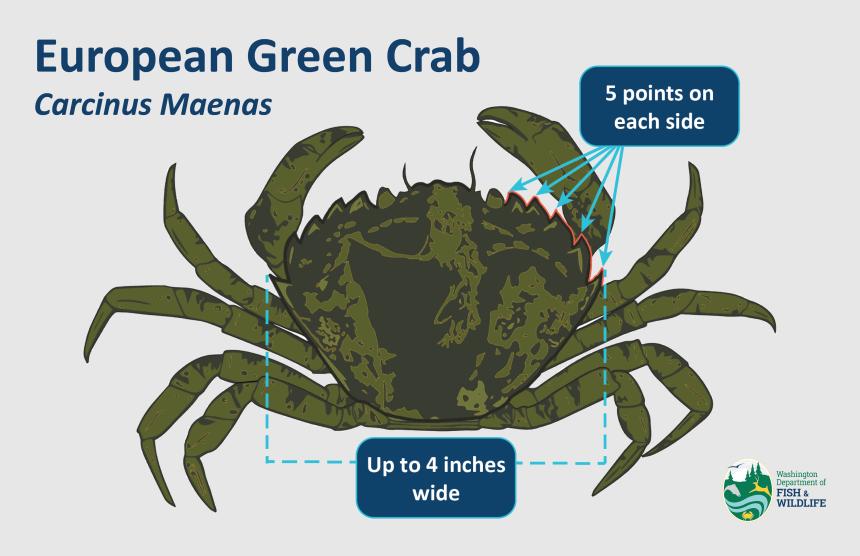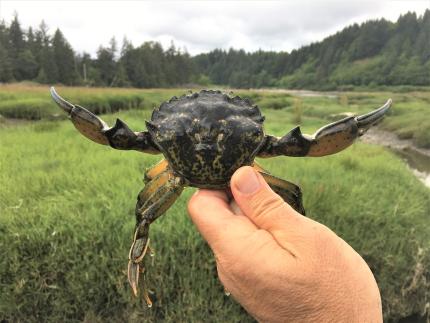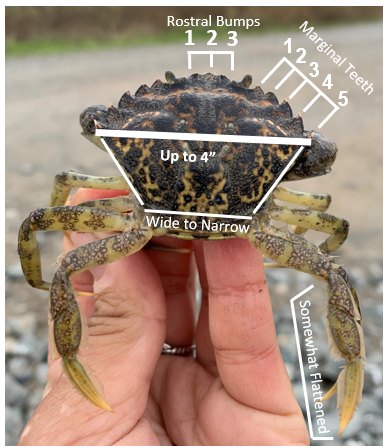If you find a suspected European green crab or its shell in Washington, take photos and report it as soon as possible using the form below. At this time, we are not asking the public to kill suspected green crabs. This may sound counterintuitive but is intended to protect native crabs from cases of mistaken identity. As a Prohibited species, it is illegal to possess a live European green crab in Washington.
Report your sighting
Please enter European green crab for Species in the form below. Take several pictures from different angles to confirm identification. It’s also helpful to include a coin or other object to help show its size. Refer to WDFW's Crabs of Washington one-pager (PDF) for tips on identifying native and invasive crab species. Scroll down for more information.

Other ways to report European green crabs
You can also report European green crab sightings through the Washington Invasive Species Council app.
Or call WDFW Aquatic Invasive Species staff at 1-888-WDFW-AIS (1-888-933-9247).

This webpage includes information for the public on European green crab identification and reporting. For more detailed resources as well as management updates, please visit the European green crab species page or sign up for our email list.
A destructive invader
European green crabs are a globally damaging invasive species that pose a threat to Washington's economic, environmental, and cultural resources.
Potential impacts include destruction of eelgrass beds and estuarine marsh habitats, threats to the harvest of wild shellfish and the shellfish aquaculture industry, the Dungeness crab fishery, salmon recovery, and a complex array of ecological impacts to food webs.
A map showing where green crabs have been detected in Washington is available on the European green crab species webpage.
Catch updates are published on WDFW's interactive European Green Crab Hub, which supports coordination of ongoing emergency measures, data collection, and science.
Learn more in this recorded presentation from Washington Department of Fish and Wildlife (WDFW)'s aquatic invasive species research scientist. The below Northwest Now video segment from August 2022 also covers European green crab concerns and management in Washington.
How to identify the European green crab
In the Pacific Northwest, there are many small, green native crabs that are easily confused with European green crabs unless you have a trained eye. In addition, green crabs can actually turn quite red as they age. In Washington state, the European green crab is most often confused with native helmet crab or hairy shore crab.
European green crabs are shore crabs and are found in shallow areas—typically less than 25 feet of water—including estuaries, mudflats, intertidal zones, and beaches. They are not likely to be caught by recreational shrimpers or crabbers operating in deeper water, but may be encountered by beachgoers, waders, clam and oyster harvesters, or those crabbing off docks or piers in shallow areas.

Download WDFW's Crabs of Washington identification guide (PDF).
Or visit the Resources section of our European crab species webpage for more identification guides.
Spines
The most distinctive feature of the European green crab is not its color – which can vary from reddish to a dark mottled green – but the five spines or teeth on each side of the shell. This number of spines is different from any other crab you are likely to see on the beach.
Size
At its largest, the back shell (carapace) measures up to 4 inches across, but it is more common to find smaller, younger crabs, often around the size of a quarter. Males are generally larger than females of the same age.
Color
Although known by the common name of green crab, color is not its distinguishing feature. Juvenile crabs can change their shell color to match their surroundings each time they molt. Adults are usually dark greenish with yellow markings, and often have some orange at the joints. The underside of the crab is off-white, but can sometimes be bright yellow or even red.
Shape
The back shell (carapace) is wider at the front than the back. The best way to distinguish the green crab from other species is by the number of spines next to the eye (marginal teeth). The green crab is entirely distinct from other native crabs with its five marginal teeth.
Legs and claws
The green crab has relatively long legs compared to the main body, and narrow claws. The last pair of legs is slightly flattened.
Regulations
WDFW is not asking the public to kill suspected green crabs. This is to protect native crab species, which are often misidentified, particularly helmet, kelp, and hairy shore crabs. It might be hard to let a crab go when you are concerned it could be invasive, but keep in mind WDFW will respond quickly to confirmed sightings in new areas, and the best thing you can do is to get the information to us as soon as possible.
European green crab are classified as a Prohibited Level 1 Invasive Species in Washington, meaning live crabs may not be possessed or retained, introduced on or into a water body or property, or trafficked (transported, bought or sold), without department authorization, a permit, or as otherwise provided by rule.
Under Washington state regulations, prohibited invasive species may be killed and returned to the water where they were found, or retained once dead, if the person is certain about species identification and assumes responsibility for correct identification and adherence to state rules and fishing regulations. This regulation is also included in the crab rules section of the Washington Sport Fishing Rules.
Targeting EGC with traps requires a permit from WDFW. For those who own or manage shellfish beds, beaches, or tidelands, support and permits for European green crab control may be available. Please contact ais@dfw.wa.gov.
Beachgoers, anglers, recreational crabbers, and others are asked not to tamper with European green crab traps, which are often deployed in shallow areas exposed at low tide and are typically identified with a bright orange buoy and an official green tag or permit.
Are European green crabs edible?
Though considered edible and fished commercially in parts of their native range, European green crabs aren’t any bigger than your fist and don't make the most appealing meal. Where eaten, they are used primarily for crab stock and soup.
WDFW, West Coast tribes, agencies, and other partners continue researching and experimenting with responsible ways to use the biomass from European green crabs that have been trapped, removed from Washington waters, and humanely killed through freezing, including for compost or fish feed.
Join the Washington Sea Grant Crab Team
WDFW has teamed up with the Washington Sea Grant Crab Team who is leading a volunteer-based early detection and monitoring program for European green crab. The Crab Team is also working to improve the understanding of native salt marsh and pocket estuary organisms and how they could be affected by green crabs.
To learn more about early detection, monitoring, and volunteer opportunities, please visit Washington Sea Grant's Crab Team website or check out our European Green Crab Hub, which supports coordination of ongoing emergency measures, data collection, and science.